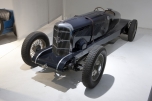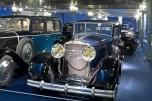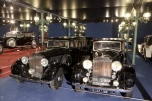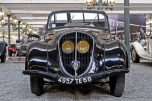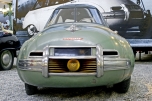Cars from 1920 to 1950 - The golden age of the car
Delahaye 135M
1949
Code 5029
Body style: coach profilé
When Emile Delahaye passed away in 1905, he passed on his business to Charles Weiffenbach from Alsace, who developed it through the production of high-quality, fast and reliable cars. In late 1933, the firm changed its sales policy drastically, with a determined focus on large sports roadsters. From 1934 to 1940, these attractive vehicles were successful both in concours d’elegance and in races. The Type 135, a leading light in this period, was powered by a six-cylinder, 3557 cc engine. Several versions appeared from 1935 onwards, including the 135 MS competition model, which won the 24 Hours of Le Mans in 1938.
The 135 chassis was brought back out after the war, and the leading French coachbuilders were called upon to build a body for it. Some tried a neo-modern styling, not always with great success, while other designs gently updated the 1939 lines, and were rather better received. Some of the top coachbuilders, however, designed radically new shapes. The Delahaye 20 CV, Code 5027, is in this respect exceptional. It was designed and built by Antem and brings together pure, sweeping lines and extreme luxury. Safety standards were not yet very tight and the designer was free to shape the external decoration and the internal fittings. However, what is really remarkable about this car are its ingenious features, such as removable front wing panels to facilitate access to the engine. The unreservedly French aesthetics of this splendid coach body marked the end of the golden age for French coachbuilding.
This car was donated to the Museum by Mrs Dina Marine, widow of Mr Victor Marine of Carmel (California). This model had been their honeymoon car. On 25 October 1951, the Marines boarded a ship in Le Havre with their brand new Delahaye from the Paris Motor Show, bound for the USA. They drove the Delahaye from New York to San Francisco, but after 1955 this jewel of the road was retired from service, having only ever clocked 40,000 km (25,000 miles).











